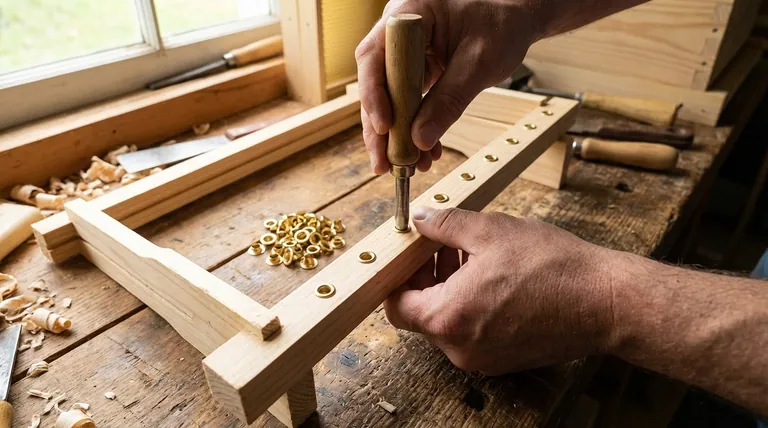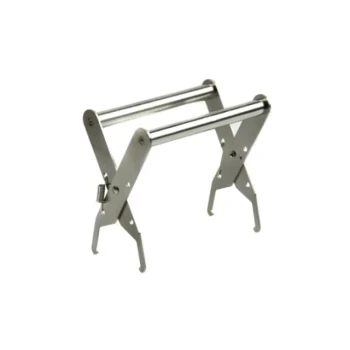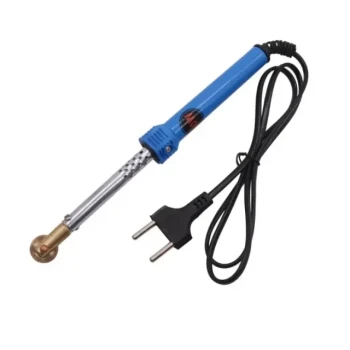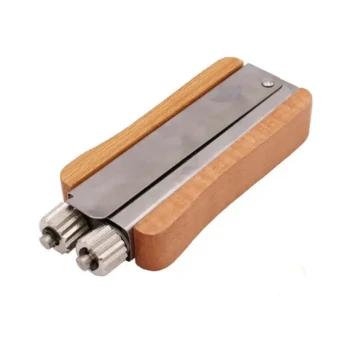To install eyelets, you use a specialized tool called an eyelet punch to pick up each eyelet and press it firmly into the pre-drilled holes on the side bars of a wooden beehive frame. The goal is to seat the eyelet snugly within the wood, creating a smooth, reinforced passage for wiring.
The core purpose of installing eyelets is not just a mechanical step; it is to reinforce the soft wood of the frame, preventing the high-tension support wires from cutting into and damaging it over time.

Why Eyelets Are a Critical Component
Before beginning installation, it's essential to understand why this small component plays such a significant role in the longevity and function of your frames, specifically when using wax foundation.
Reinforcing the Frame's Wood
The wire used to support a sheet of wax foundation must be pulled taut. This tension exerts constant pressure on the wood where the wire enters and exits the frame.
Without reinforcement, this thin wire will gradually slice into the soft wood of the side bars, causing the wire to loosen.
Ensuring Foundation Stability
When support wires become slack, the wax foundation can sag, warp, or bulge. This leads to improperly drawn comb, which can disrupt the colony's structure and make hive inspections more difficult.
Eyelets provide a smooth, durable metal surface that allows wire to be properly tensioned without damaging the frame, keeping the foundation perfectly straight.
Extending the Life of Your Equipment
By preventing the wire from digging into the wood, eyelets protect the structural integrity of your frames. This small, inexpensive component significantly extends the usable life of your woodenware, protecting your investment.
The Installation Process Explained
The process is straightforward once you have the correct tool. A typical deep frame will require eight eyelets per side bar.
The Essential Tool: An Eyelet Punch
This simple, purpose-built tool has a pointed tip designed to fit perfectly into the hole of an eyelet. It allows you to pick up the eyelet and provides the leverage needed to press it into place.
Step 1: Picking Up the Eyelet
Spread your eyelets on a flat surface. Press the tip of the eyelet punch firmly into the center of an eyelet to pick it up. The eyelet should hold securely onto the end of the tool.
Step 2: Inserting into the Frame Hole
Align the eyelet with one of the pre-drilled holes on the frame's side bar. Apply steady, firm pressure to push the eyelet into the wood until its flange is flush and snug against the surface.
Understanding the Trade-offs: When Not to Use Eyelets
While critical for some setups, eyelets are not a universal requirement. Understanding when they are unnecessary is just as important as knowing how to install them.
Frames with Plastic Foundation
If you are using solid plastic foundation sheets, eyelets and wiring are not needed. This type of foundation is rigid and self-supporting.
The plastic sheet simply snaps into the grooves of the frame, providing the bees with a durable base to draw comb without any additional support.
Frames Without Pre-Drilled Holes
Some frames are manufactured specifically for use with plastic foundation and do not have holes drilled into the side bars. This is a clear indicator that eyelets are not part of the intended assembly for that particular frame style.
Making the Right Choice for Your Goal
Your choice of foundation dictates whether eyelet installation is a necessary step.
- If your primary focus is using natural wax foundation: Installing eyelets in every frame hole is a mandatory step to ensure long-term stability and frame durability.
- If your primary focus is convenience and durability with plastic foundation: You can skip the eyelet installation process entirely, as it serves no function in this system.
Properly preparing your frames for their intended purpose is a foundational step in successful beekeeping.
Summary Table:
| Key Consideration | Description |
|---|---|
| Primary Purpose | Reinforces the wooden frame to prevent high-tension wires from cutting into the wood. |
| Essential Tool | An eyelet punch is required for picking up and pressing the eyelets into place. |
| When Are They Needed? | Mandatory for frames using wax foundation that requires wiring. |
| When Are They NOT Needed? | Not required for frames using rigid, self-supporting plastic foundation. |
Ensure the longevity of your apiary equipment with the right supplies. Properly installed eyelets are a small detail that makes a huge difference in frame durability. At HONESTBEE, we supply high-quality beekeeping supplies and equipment, including eyelets and the tools needed to install them, to commercial apiaries and beekeeping equipment distributors. Protect your investment and keep your foundations straight—contact our wholesale experts today to discuss your needs!
Visual Guide

Related Products
- HONESTBEE Premium Italian Style Hive Tool with Hardwood Handle
- Multi-Function Plier-Style Frame Grip Hive Tool
- HONESTBEE Advanced Ergonomic Stainless Steel Hive Tool for Beekeeping
- HONESTBEE Professional Multi-Functional Hive Tool with Ergonomic Wood Handle
- HONESTBEE Professional Long Handled Hive Tool with Precision Cutting Blade
People Also Ask
- What are some common uses of a hive tool? Essential Multi-Purpose Tool for Every Beekeeper
- How should beekeepers handle bees when using a hive tool? Master Calm, Deliberate Techniques
- Is it advisable to manage a large number of hives alone? The Risks of Solo Beekeeping at Scale
- What is required for regular inspections in both Flow Hives and Langstroth hives? Essential Beekeeping Tasks Explained
- What maintenance steps are recommended for hive tools? Ensure Longevity & Apiary Health



















